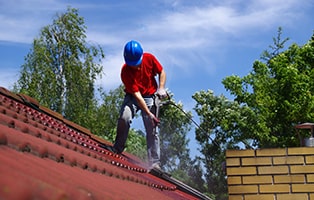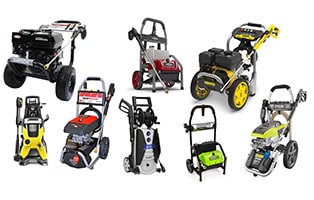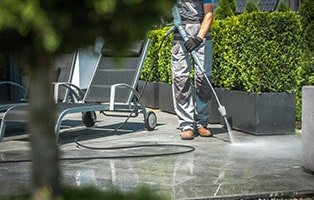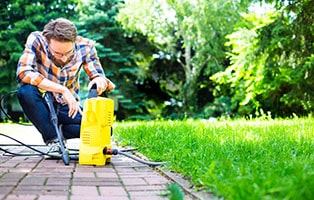How Does A Pressure Washer Work? Here’s Everything You Need To Know When You’re Ready To Buy One
Do you have stubborn stains on your patio, deck, or driveway? If so, scrubbing for hours like a madman or using caustic chemicals isn’t how to get rid of them. Instead, work smarter (and not harder) by investing in a power washer.
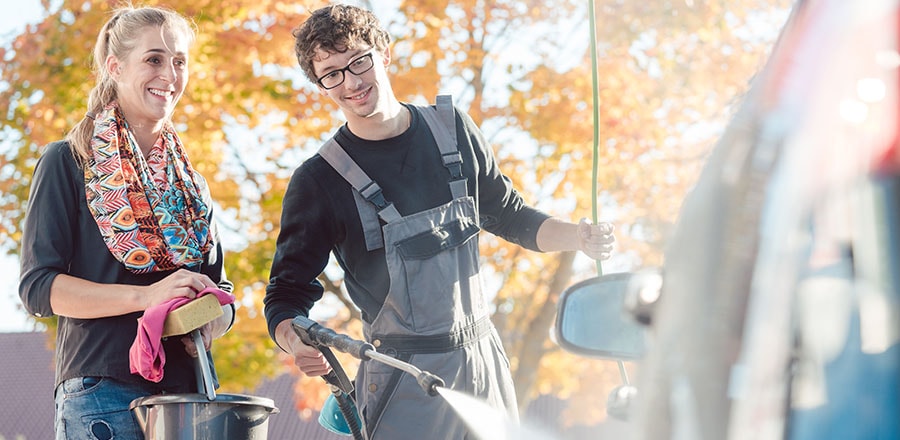
These easy-to-use, simple-to-operate gizmos generate 1,500 to 3,000 pounds of pressure per square inch to make quick work of unsightly blotches that detract from the beauty of your outdoor furnishings. It’s able to do this because the powerful force of the water streaming out of the wand is like a zillion tiny little laser guns blasting away at grime and accumulated filth.
Pressure washers have about 75 times the pressure of a garden hose. All that power makes light work of even the toughest cleaning jobs. Mother Nature can be hard on all of your outdoor surfaces, and mud, dust, and grime can really build up. That’s why it’s a fantastic idea to use a pressure washer to give all these surfaces a proper washing down at least once a year.
Let’s say you have an oil smear on your driveway. If you had a pressure washer, you could get rid of that hideous stain within minutes!

Talking Terms
There are some terms you need to be aware of, so you know how effective the pressure washer you’re about to buy is.
One of these terms is PSI, or pounds per square inch. This is the pressure of the water when it leaves the nozzle, and it’s what gives you the power to blast through countless layers of gunk.
There’s also GPM or gallons per minute. This gives you the flow you’ll need to wash all that gunk away.
The Anatomy of a Pressure Washer
A pressure washer is merely a machine that generates a powerful stream of H2O. You can use this stream to clean things. Here are the most essential parts of this useful machine:
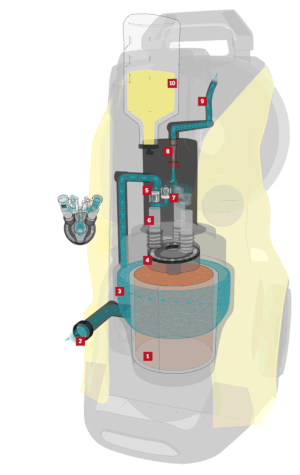
- Water inlet: The journey of the water through the pressure washer starts at the water inlet. This connects the machine to a water supply. The inlet also has a filter that traps any grit suspended in the water. This is a great thing to have because you don’t want anything clogging up your machine. That could make for a costly repair! Also, tiny stony particles shooting out of the business end of the wand could cause severe damage to whatever you’re washing.
- Power source: Your pressure washer needs a power source to do its work. That’s going to be either an engine that runs on gasoline or an electrically powered motor. Gas engines provide the highest amount of force. However, an area in which you might have to use one might not have an electrical outlet nearby. Also, a trailing power cord could be a real safety hazard in some situations.
- Water pump: The power source drives the pump system, which circulates water within the machine. The pump first pushes water into a double-walled casing surrounding the motor. This cools the water down in case it’s too hot. Hot water can destroy the unit’s innards. The pump can be an axial pump or a triplex pump.
- Plungers: Part of the pump system consists of three plungers. The pump is connected to something called a wobble plate, which moves the plungers up and down. These plungers operate in much the same way that engine pistons do. The downward movement of the pistons pulls the water through a suction valve and into the plunger chamber. As each plunger moves upwards, they pull water out of the chamber and through a pressure valve.
- Injector: From the pressure valve, the water goes into the injector. This is where soap or chemicals are added if needed.
- High-pressure house: This is the hose that attaches from the main unit to the wand. It’s composed of wire mesh and a couple of layers of high-density plastic. Because of its heavy-duty construction, it can stand up to the tremendous kinetic energy of the water coursing through it.
- Wand and attachments: There are many types of pressure washer attachments. For example, the most basic type is a simple valve that lets water squirt out whenever you squeeze the trigger. There are turbo and rotary attachments, as well as chemical injector and soap nozzles. These nozzles are powered solely by the force of the water flowing through the hose. Each nozzle is suitable for a particular kind of job.
- Residual current devices (RCDs): Try to get a pressure washer with one of these safety devices built-in. That’s because you’re using a machine that mixes both electricity and water. You’re going to want to have a mechanism that can detect electrical faults so it can shut off the power when that happens. Don’t worry—there’s a plastic casing around the motor to prevent water from getting in. This means that electrical faults very rarely, if ever, happen.
- Thermal release valve: Another safety feature is something called a thermal release valve. If the user keeps the pressure washer running for an extended period without activating the trigger, this valve will open. Then, heated water is flushed out, so cooler water can enter the pump.
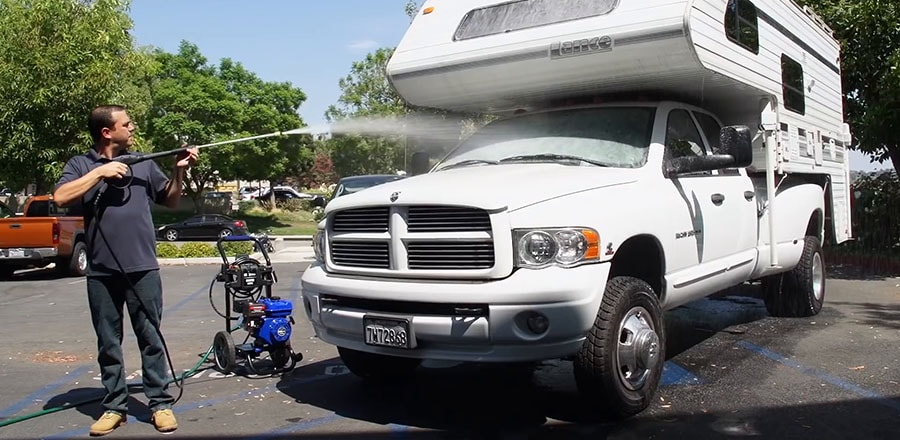
Dirt’s Escape Route

When you’re doing a job, there’s going to be lots of dirt being sprayed off whatever surface you’re washing. And, all that filth must go somewhere.
So, make sure you plan the direction you want to spray in, so the dirt doesn’t end up where it shouldn’t. This will only create more headaches for you.
Which isn’t a good thing, because a pressure washer is supposed to make your life easier—not harder!
Gasoline Versus Electric Powered Pressure Washers
Electric pressure washers are light and compact, which makes them easy to move around. If you’re doing routine cleaning tasks, one of these machines might be sufficient. Check out our TOP-7 electric pressure washers if you need some assistance buying one.
For more heavy-duty jobs, you might need a gasoline-powered pressure washer. And good news! We’ve made your buying decision so much easier because we’ve selected what we consider to be the TOP-6 gas powered washers on the planet.
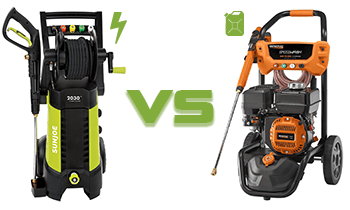
Most gasoline pressure washers use a four-cycle engine to drive the pump. To rev up the engine, the start switch must be set to run position. Then, you pull the starter rope.
Many engines have a choke on the carburetor to assist with starting. This is especially helpful when the engine is cold. The choke limits airflow through the carburetor so more fuel can enter the cylinder. You control the engine’s speed with a throttle lever.
Pressure washer engines are designed to be used with no more than 10% ethanol. Gasoline with higher levels of ethanol than this is liable to cause problems by damaging the fuel system.
Choose Attachments Wisely
Choose your attachments wisely. That’s because the powerful force of water coming out of the business end of the wand can damage delicate surfaces. For example, if you use them on old windows with brittle wood, you can cause the seal around the window to crack.
This could let drafts, and even worse, moisture, to invade your home. Make sure that the attachment doesn’t generate more pressure than a surface can withstand.
If you want to add detergent to your water stream, you’ll have to choose a low-pressure nozzle.
Test Out an Area First
Always test out whether you’re going to damage your surface by testing a part of it that people aren’t going to see. This way, you won’t be risking damaging the entire surface.
Artistic Applications
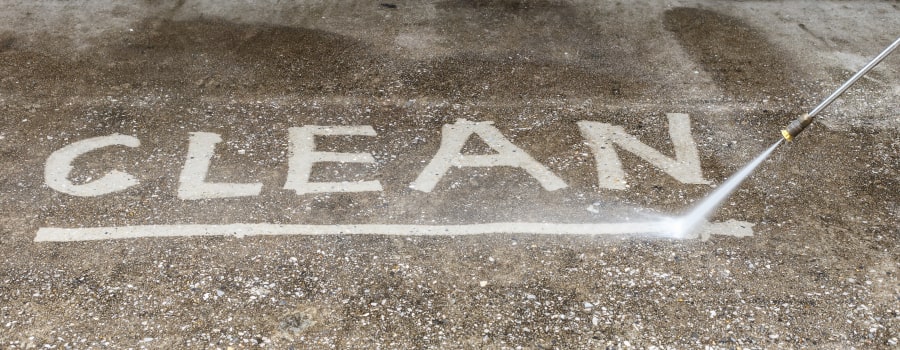
If you’re up for a little art of the unconventional sort, you might be surprised you can use your pressure washer as a high-tech paintbrush. To do that, place a stencil on a dirt-encrusted surface—the filthier, the better.
Your canvas should be as flat and as smooth as possible. Then, spray your stencil, so all the blank spaces get sprayed with water.
Voila! You’ve just created an artistic masterpiece that will, unfortunately, fade over time.
Final Words
If you want to keep all your outdoor furnishings and surfaces looking like new, invest in a pressure washer. That way, you’ll get your tough cleaning jobs done in a fraction of the time it would take if you were only using elbow grease and potentially toxic chemicals.
Plus, you won’t breathe in all those poisonous fumes! If you don’t already own one, I highly recommend you get one. Your life will be SO much easier when you do.
To get you started, check out these pressure washer reviews. Happy shopping!

Pressure Washer Tips & Tricks
